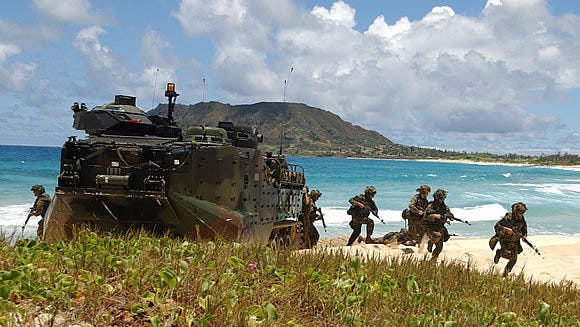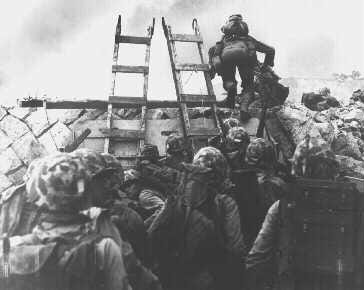This essay is part of the Personal Theories of Power series, which asked a group of national security professionals to provide their theory of power and its application. We hope this launches a long and insightful debate that may one day shape policy.
The two giants of sea power theory, Alfred Thayer Mahan and Sir Julian Corbett, both touched on amphibious operations but both are properly considered sea power theorists. Mahan disliked amphibious operations, declaring that they were “harder to sustain than to make.” He judged them dangerous to those forces extended ashore and that this danger outweighed their potential benefit. In Mahan’s cost-benefit analysis of amphibious operations, they were a waste of resources. Mahan viewed the sea power side of the equation as decisive.
Corbett, however, was more of a fan. Corbett thought that naval forces could rarely be decisive on their own and thus need the ability to project land forces ashore to achieve a decision. But, amphibious forces are dependent on naval forces for protection from enemy naval forces, supply and sustainment, and fire support. For Corbett, the land power side of the equation is decisive.
A little known theorist came down right in the middle. Lieutenant Colonel Earl “Pete” Ellis, USMC, wrote about naval and amphibious strategy in the early 20th Century, including the Marine Corps’ contribution to War Plan Orange, Advanced Base Operations in Micronesia. Ellis viewed amphibious power as a symbiotic relationship between land and sea power. Expeditionary land forces are dependent on naval forces for the necessary sea control, transport, sustainment, and fire support. Naval forces are dependent on those land forces to secure key littoral terrain for protection and to secure forward supply bases. In the course of this analysis, he identified the need for specialized, task-organized amphibious forces that could fill this niche, especially since amphibious assaults were becoming far more difficult in the face of modern artillery and machine guns. Since the focus of all of his writings was on those amphibious forces and their uses, he is perhaps the only amphibious power theorist in history. For Ellis, the mutually reinforcing symbiosis of land and sea power was decisive. He was proved correct during World War II: the US Navy could not strike at the heart of the Imperial Japan without seizing lodgments across the Pacific and Marine and Army forces could not seize those lodgments without Navy transportation, support, and sea control.

In Colin S. Gray’s Theory of War Taxonomy, this theory of amphibious power falls into a category along with Mahan, Douhet, and Schelling. It is clearly not a general theory nor is it a general theory of a domain as it exists at the confluence of land, sea, and air. It does explain “how a particular kind or use of a military power strategically affects the course of conflict as a whole.” A brief look at history illuminates this point.
The Influence of Amphibious Power on History
A few examples from history suffice to illustrate the timeless nature of amphibious power. The first occurred early in the Peloponnesian War. Sparta began the war dominant on land, while Athens was dominant at sea. While Spartan land power allowed her to ravage the fields before Athens herself, Athenian fleets plied the waters of the Mediterranean. In 425 BC, Thucydides landed a fleet at Pylos in Spartan-controlled territory. The fighting that occurred at Pylos and the offshore island of Sphacteria eventually led to the defeat and capture of about 300 Spartan hoplites by Athenian expeditionary forces. Land power and sea control did not lead directly to strategic effect, but the use of sea power to project land power to defeat and capture Spartan hoplites shocked the Greek world and led directly to the Peace of Nicias. The Athenians subsequently botched the peace and thus squandered the strategic effect garnered, but they would not have had the opportunity at all if not for the use of amphibious power.
The second example occurred during the Second Punic War. The sea control of the Mediterranean gained by the Romans after the First Punic War had profound strategic effects: it force Hannibal into a difficult march through the Alps which depleted the combat power he was able to bring to Italy and prevented significant reinforcement once he had gained a lodgment in Italy. His eventual defeat there, however, failed to end the war with Carthage. It was not until Scipio used sea control to project Roman land power across the sea to Carthage itself that decisive effects occurred and Carthage surrendered.
During the American Civil War, Union forces secured sea control early on and held it throughout the war as part of the Anaconda Plan. While the Anaconda Plan certainly produced strategic effects that choked the Confederacy off from reliable and consistent sources of supply, it did not have decisive effects by itself. In this case, amphibious power would not have decisive effects but the tactical level is interesting. Union General Ambrose Burnside was an amphibious visionary. As a Brigadier General, he formed an expeditionary force and developed radically new ship-to-shore tactics which allowed him to seize virtually all of coastal North Carolina for the Union.
Another waypoint in the history of amphibious operations occurred in 1915. During the Gallipoli campaign, British forces attempted to seize control of the Dardanelles from the Turks, allied with Germany. While the attempt failed, it is easy to see what kind of strategic effects victory could have produced. If British and French forces seize the Dardanelles, control of Constantinople could have easily followed, knocking Turkey out of the war entirely. Additionally, control of the Dardanelles would have allowed supplies from the Western allies to flow to the Eastern front, shoring up their Russian allies. The British and French had the sea power and the land power, but using both as amphibious power had great potential, if unrealized.
Lastly, World War II proved to be a high water mark for amphibious operations. In the Western theater, the Allies also largely secured sea control while Germany dominated the continent. That sea control granted the allies the ability to project power ashore in Africa, Italy, and eventually in France. In the Pacific Theater, the entire Allied strategy depended on amphibious power. A measure of sea control was gained by the U.S. after the battle of Midway, but amphibious power was necessary to secure lodgments to allow the U.S. to project force across the Pacific Ocean. That sea control had to be translated into force projection ashore at dozens of islands, producing a credible threat of an amphibious assault on Japan herself and the ability to use air power to strike Japanese soil.
Conclusions from Theory and Praxis
Sea power can enable land power, land power can enable sea power, and the projection of power ashore is now dependent on air power. The fusion of all of these capabilities is amphibious power.
Specialized troops are needed to wield credible and effective amphibious power. Burnside’s pick-up team of amphibious soldiers ran into daunting tactical problems in North Carolina. While U.S. Army troops drew on Marine tactics in the European theater, hard lessons had to be learned in North Africa and at Anzio and Salerno.
Despite the need for specialized troops to effectively conduct amphibious operations, amphibious operations are never solely the interest of marines. Navy forces and air support are essential to success and must train to the unique problems associated with projecting land power ashore. Armies are also concerned with amphibious operations. In a large scale conflict, there will not be enough Marines to conduct every assault. While the U.S. Army famously conducted more amphibious operations than the U.S. Marine Corps during World War II, they did so using doctrine developed by the Marines and capabilities already resident in the Navy.

Strategic Effects
There are numerous tactical lessons that can be learned from history as well. James Wolfe’s campaign in Quebec during the Seven Years War is illustrative as is MacArthur’s master stroke at Inchon in 1950. Both battles achieved far reaching strategic effects. Amphibious power provides options to the side that has it, and the mere threat of amphibious forces the opponent to expend resources to defend against it, constraining his options. During the Gulf War, U.S. Marine forces aboard ship in the Persian Gulf forced Iraqi forces to station seven infantry divisions along the Iraqi coast to prevent a landing, depleting their combat power in Kuwait. Amphibious power, in and of itself, will rarely be directly decisive at the strategic level. It does, however, indirectly contribute to strategic effects because of the options it grants to the joint force. It is usually necessary to establish beachheads through which ground forces can flow, it can extend the range and reach of air forces, and can control littoral chokepoints to ensure the safety of naval forces. Additionally, amphibious power forces the enemy to defend their shores everywhere an amphibious assault is possible, consuming their resources and tying down combat power. Shifting defenders from one shore to another simply opens up another opportunity for a successful assault. Thus, a theory of amphibious power explains how that particular capability can affect the course of conflicts.

Well thank you for the rather complete and concise history of amphibious warfare. My recollection of the preparation for a Kuwaiti landing in the first Desert War was that six people were killed in rehersals.
The human costs of the landings in WWII may well have been necessary; but these were strategic decisions reached, based on the imperative that we were going to win the total and complete surrender of the Germans and Japanese. Everything was secondary to this decision.
I note that you did not care to mention the history of amphibious warfare during the Korean campaign. I would suggest that was when the Navy/Marine Corps Team “jumped the shark” to put it in Hollywood parlance. In point of fact, I would say that these beach operations have rapidly decreasing relevance to the emerging conflicts for which we plan and program the severely constrained DOD budget.
Does national strategy actually drive readiness for amphibious landings of the sort you have outlined? I think not. We would be better prepared to restore our attack (ASW) submarine fleet and prepare to replace the aging assets of naval aviation, while stopping the atrophy of the our combatant missile fleet’s cruiser and destroyers.
The argument that becuase amphibious assault was useful in the past, it will be in the future, is not, in my opinion supported by strategy or geography.
I do like that the author saw fit to mention that the US Army conducted more amphibious assaults than the marines. More specifically they conducted more amphibious assaults in the Pacific theatre of operations, killed more japanese, and captured more territory than the marines.
Honestly the US Marine Corps would be better served by becoming a proper expeditionary force along the French model where units specialize in amphibious assault, parachute assault, mechanized, or mountain warfare. And lose the independent air arm. costs billions and simply replicates existing capabilities at a greater cost.